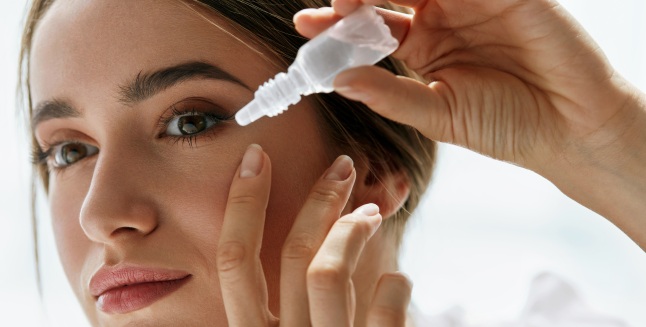Dry eye syndrome

The causes of this disease are multiple and start from a simple quantitative deficiency of lacrimal secretions, to inflammatory causes, tumors located in the lacrimal gland, with postoperative sequelae, small trauma, various local irritations created by cosmetic or even medicinal products. Another quite common cause is that lacrimal secretion is normal but tear evaporation occurs very quickly because the oily external layer is produced in a small amount. This can be caused by burns or trauma affecting the Meibomius glands, which are responsible for the oily component. There are other causes in which we may experience this disorder from the lacrimal gland that can cause exophthalmia, as well as neurological diseases such as various paresis in the facial area, or. There are also conditions associated with collagen diseases such as: rheumatoid arthritis, systemic lupus erythematosus, psoriatic arthritis, scleroderma, but also general disorders such as liver cirrhosis, chronic conjunctivitis, etc. .
In addition to the aforementioned conditions that cause dry eye syndrome, there are also causes that maintain this condition, such as dry climate, pollutant environment, eye area, long contact lens wear, etc. . The main symptoms are: - feeling of stinging at the eye level - sometimes permanent burning sensation - feeling of \. The diagnostic principle is a relatively simple one, following a visit to the ophthalmologist who, after the symptoms of the symptomatology, finalizes the diagnosis and initiates a proper treatment. Most of the symptoms described above are caused by local inflammation which, over time, can be complicated by the occurrence of erosions or ulcerations in the cornea and permanent impairment of vision.
When these complications occur, one can discuss the sicca keratoconjunctivitis. In the ophthalmologic examination, the eyelids, the cornea and the conjunctiva are tested, but the lacrimal film is evaluated by the appearance and consistency. To evaluate lacrimal secretion, the ophthalmologist makes a test called the Schirmer test, which consists in applying a special filter paper to the lower conjunctival sac in both eyes and the patient is asked for 5 minutes to keep the eyes closed. After 5 minutes, the filter paper moistens with lacrimal secretions to a certain degree, which varies from patient to patient. The test is interpreted by the ophthalmologist and if the secretion is less than 15 mm, then it is a lacrimal hypo-creatine, and the diagnosis is the.
Artificial tears are the main indication in dry eye syndrome to replace poorly secreted. These tears contain substances with a nutritional role based on, a component found naturally in the eye film. Products containing artificial tears are either droplet-treated, 1-2 drops 2-3 times a day in the conjunctival sac or whenever the patient feels dry and as a spray, . If the condition gets a more serious form, it is possible to use hydrophilic therapeutic special lenses or silicone devices or at the lower lacrimal point. To eliminate these problems definitively and to get rid of the permanent application of a system of mechanical occlusion of the holes through which the tears run through the nose.
The goal was to \. When the ophthalmologist recommends this treatment by plugging the lids with special silicone lids that are compatible with the human body, you should know that the operation is painless because eye drops will be given with an anesthetic and this will take a few minutes, do not require admission or supervision . However, for this modern technique, there are also contraindications that prevent the installation of silicone plugs because it increases the risk of contamination and spreading of the infection, possible narrowing or obstruction of the tear paths, eyelid inflammation or lacrimal hypereceria, all of which can . ConclusionsIf they have been recently diagnosed with dry eye syndrome or initiated therapy, patients should note that the presence of two or more specific symptoms necessarily implies a specialist consultation. .
Source : sfatulmedicului.ro
Views : 3251
Popular Article
- (photo) Nude becomes art.
Posted: 2018-03-17, 9815 views.
- The harmful effects of air conditioning on the skin
Posted: 2017-06-08, 8527 views.
- 3 causes of dyed hair discoloration
Posted: 2017-06-15, 8408 views.
- Why early puberty occurs in girls: symptoms, favors, diagnosis and treatment
Posted: 2017-10-24, 8253 views.
- Good or bad skin treatments in the hot season
Posted: 2017-06-07, 7981 views.
Recommendations
- (photo) Nude becomes art.
Posted: 2018-03-17, 9815 views.
- The harmful effects of air conditioning on the skin
Posted: 2017-06-08, 8527 views.
- 3 causes of dyed hair discoloration
Posted: 2017-06-15, 8408 views.
- Good or bad skin treatments in the hot season
Posted: 2017-06-07, 7981 views.
- Risks of practicing sports on hot days
Posted: 2017-06-12, 7557 views.
 4 effective ingredients in the fight against acne.
4 effective ingredients in the fight against acne. How to get rid of hiccups fast
How to get rid of hiccups fast The wheat bran diet: the secret of lost pounds as if by magic
The wheat bran diet: the secret of lost pounds as if by magic The recipe that will sweeten your soul this weekend!
The recipe that will sweeten your soul this weekend!  Is it dangerous or not to refreeze meat after thawing it?
Is it dangerous or not to refreeze meat after thawing it?  The unusual sign of diabetes indicated by saliva.
The unusual sign of diabetes indicated by saliva. What to drink to boost your immune system.
What to drink to boost your immune system. 10 foods that help you never age.
10 foods that help you never age. What actually happens in your body if you drink a cup of coffee for breakfast
What actually happens in your body if you drink a cup of coffee for breakfast 5 surprising benefits of chia seeds
5 surprising benefits of chia seeds